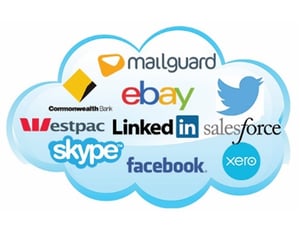Like a lot of technical jargon, the cloud is a confusing term for a comparatively simple concept: any service delivered over the internet via a user name and password.
Cloud computing has already become an integral part of most of our lives. It’s how we do our banking and our shopping. It’s how we access social media services such as LinkedIn and Facebook. Increasingly, it’s how we watch television series’ and movies.
In fact, global companies, such as the American video streaming service, Netflix, have used the cloud to penetrate the Australian market. In doing so, they have disrupted the film industry and eradicated the local video store. The cloud is a simple concept, but a disruptive business model.
Big international companies, with the budgets to research the best technology, are the fastest adopters of cloud computing as a way of delivering their products and services.
In Australia, it’s a different picture. Although our banks have been early adopters, many other large companies have held back. The same goes for small and medium-sized companies. Only one in five bought cloud services in 2014, the Australia Bureau of Statistics reports.
Most companies are waiting to see whether the promises of cloud – dramatically reduced costs and complexity – outweigh any issues, such as security, performance and control.

Getting to know the cloud
It’s strange to think that we once used to wait weeks or months to watch our favourite TV series on DVD. Now, of course, we stream episodes from a cloud-based platform, like Netflix, and watch when we want to. It’s faster, cheaper and more convenient.
We’ve become familiar with the cloud as consumers. We’ve learned to entrust our personal and financial details with online banking. Without a second thought, we use Facebook to keep up with friends and family and LinkedIn to connect with colleagues. If we were suddenly stripped of access to these services, life would be a whole lot less convenient.
Still, it’s a different matter to move our businesses to the cloud. There we risk more than our own data, of course, and our duty of care makes us more cautious.
As a result, we only know one side of the cloud equation. But, as Netflix’s penetration into the Australian market shows us, we are reaching a tipping point. There is a risk of leaving the move too late.
Companies (the local video shop strings to mind) that avoid cloud services for too long risk compromising their capacity to remain competitive and, ultimately, its chance of success.
How the cloud has changed
The choice around the cloud is a matter of control. Businesses can’t outsource risk, so leaders want to be sure that their cloud security and performance is as good as, or better than, their existing systems.
In hindsight, the cloud is quite a mature platform – in the dot-com days it was called SaaS (Software-as-a-Service). In the past 15 years, cloud systems have become much easier to implement and to achieve instant results.
Costs
The cloud allows companies to share computing resources – software, data, and infrastructure – and still keep their operations discreet and secure. It’s this aggregation that dramatically cuts technology costs for infrastructure, software purchases and licensing. The cost of the staff needed to maintain and update the cloud is also shared, freeing up your technology department to focus on innovation and productivity.
Productivity
With cloud systems, staff share and access the same files, information and databases creating more agile and flexible workplaces. These two qualities top the list of workplace preferences for the best talent.
Security
When it comes to security, it’s a matter of comparing existing risks against the cloud profile. As early as 2012, the cloud started to outperform non-cloud operations as far as security is concerned. And since then, a plethora of security services have launched offering protection. The best approaches to choosing providers of both cloud and cloud security providers has been well documented, offering good data for IT leaders to base their choices on.
Performance and Provider
It’s easier to move cloud providers than it is to change your mortgage today. The old system of being contracted to one provider or signed up to highly specialised architecture is redundant. As competition grows, the contracts and systems on offer are both flexible and adaptable. This gives businesses the leverage they need to keep performance standards high.
Next steps
As consumers, we know the cloud even if that is not the word we use. The words we use as consumers for cloud services are easier, faster and more flexible.
As businesses, we want our clients to experience that same ease, speed and flexibility. Over the past 15 years, cloud services have changed to deliver the cost savings, security, performance, and productivity that were promised.
The risks can be mitigated by choosing a reputable and reliable provider. The greater risk for companies today is not evolving with technology and keeping pace with our industries.
Keep up to date on the latest security trends by subscribing to MailGuard’s weekly update.







